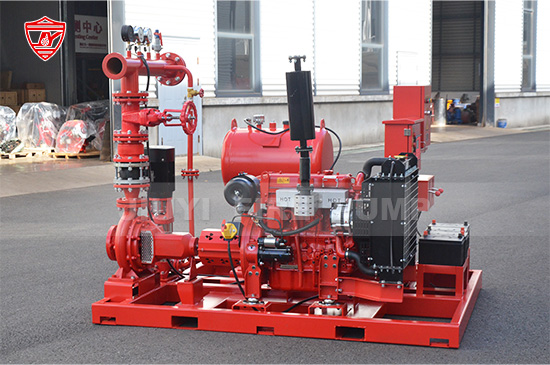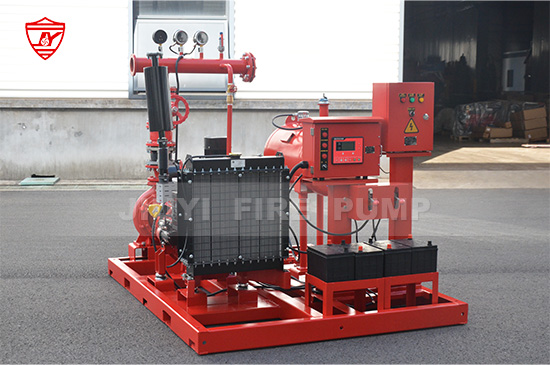In a fire protection system, the fire pump is one of the most vital components—it ensures a strong and reliable water flow when needed most. But behind every efficient fire pump is a powerful and intelligent fire pump controller, the brain that governs how the pump operates.
This article explains what a fire pump controller is, how it works, the types available, and its essential functions within a complete fire protection system. Whether you’re a fire safety engineer, a building owner, or a system integrator, understanding fire pump controllers will help ensure your system operates efficiently and complies with international standards like NFPA 20 and UL 218.

A fire pump controller is an electrical control device designed to automatically start, operate, and stop fire pumps under emergency conditions. It serves as the command center of the fire pump system, ensuring that the pump activates immediately when a drop in water pressure indicates a fire.
In simpler terms, while the fire pump provides the mechanical power to move water, the controller provides the intelligence—monitoring the system, detecting signals, and activating or shutting down the pump when necessary.
Fire pump controllers are typically designed and tested in accordance with standards such as NFPA 20 (Standard for the Installation of Stationary Pumps for Fire Protection) and UL 218 (Standard for Fire Pump Controllers).
A fire pump controller has several crucial functions that ensure reliable operation of the fire protection system, even under extreme conditions.
The primary role of the controller is to automatically start the fire pump when system pressure falls below a preset value—usually caused by one or more sprinklers opening or a hydrant being used.
After the emergency is over and water pressure returns to normal, the controller can automatically stop the pump or keep it running for a predetermined time, depending on the configuration and local regulations.
The controller also allows manual start and stop operations, giving firefighters or facility operators direct control when necessary. This feature is essential during testing, maintenance, or when the automatic start sequence fails.
A modern fire pump controller continuously monitors:
Pump running status
Power supply conditions
Phase failure or reversal
Overload or short circuit
Low or high system pressure
Failure to start
If any abnormal condition occurs, the controller activates visual and audible alarms to alert maintenance personnel or operators. These alarms are vital for ensuring quick corrective action.
The controller receives input from a pressure switch or pressure transducer that measures water pressure in the fire protection system. When the pressure drops below the set threshold, the controller immediately starts the pump to restore pressure.
In systems with multiple pumps—such as a jockey pump, electric main pump, and diesel standby pump—the controller ensures the proper sequence of operations.
The jockey pump maintains normal system pressure.
If pressure drops further, the electric fire pump starts automatically.
If the electric pump fails or power is lost, the diesel fire pump controller starts the diesel engine to ensure water supply continuity.
Controllers are equipped with various protection mechanisms to prevent damage and ensure safety:
Short-circuit and overload protection
Low oil pressure and high temperature shutdown (for diesel engine controllers)
Phase failure and reversal protection
Battery supervision in diesel systems
Advanced controllers include digital data loggers that record operational events, alarms, and test activities. This historical data helps maintenance teams identify trends and prevent future failures.
Controllers also provide manual test modes to verify pump operation without activating the entire system. This allows facility teams to perform routine inspections and confirm that the fire pump and controller are in proper working condition.
There are different types of fire pump controllers based on the pump power source and the nature of the fire protection system.
This controller is used with electric-driven fire pumps. It manages the starting and stopping of the electric motor and protects it from electrical faults.
Common starting methods include:
Across-the-Line (Direct-On-Line)
Star-Delta Start
Soft Start
Auto-Transformer Start
Electric controllers are typically equipped with circuit breakers, contactors, and relays designed for fire pump duty, ensuring quick response and reliability.
Used in diesel-driven fire pump systems, this type of controller manages engine cranking, fuel solenoids, and shutdown circuits. It also monitors vital engine parameters such as oil pressure, coolant temperature, and battery voltage.
Diesel controllers are built to start the engine automatically when electrical power fails, ensuring system reliability during blackouts.
This unit integrates both electric and diesel fire pump controllers in one cabinet or system. It allows seamless switching between power sources and provides dual protection for high-risk applications like industrial plants or high-rise buildings.
Although smaller in capacity, the jockey pump controller plays a vital role by maintaining normal system pressure and preventing unnecessary starting of the main fire pump. It’s often set to activate at a slightly higher pressure range.
Without a reliable controller, even the best-designed fire pump cannot function properly. Here are key reasons why the controller is indispensable:
Ensures Automatic Fire Response – The controller guarantees that the fire pump starts instantly, even if no one is present.
Protects System Integrity – It continuously monitors pump performance, preventing damage from overloads or mechanical failures.
Complies with Standards – Controllers designed according to NFPA 20 and UL 218 meet safety codes required for insurance and certification.
Improves System Reliability – Automatic switching and backup control ensure the system remains operational under all conditions.
Simplifies Maintenance and Testing – Built-in test functions and data recording help maintenance teams verify system performance regularly.
A typical fire pump controller consists of several key electrical and mechanical components that work together for efficient performance:
Control relays and contactors
Circuit breakers or fuses
Pressure switches or transducers
Alarm indicators and pilot lamps
Auto-manual selector switches
Event recorder or digital display panel
Battery charger (for diesel controllers)
Engine start/stop solenoids
Each component plays a critical role in ensuring that the controller operates correctly under fire emergency conditions.
Routine inspection and testing of fire pump controllers are as important as maintaining the pumps themselves. According to NFPA 25 (Standard for the Inspection, Testing, and Maintenance of Water-Based Fire Protection Systems), fire pump controllers should be inspected weekly and tested monthly.
Maintenance activities include:
Checking control panel indicators and alarms
Verifying pressure switch settings
Ensuring wiring and terminals are secure
Testing manual and automatic start/stop functions
Reviewing event logs and alarm history
Proper maintenance ensures the controller remains in perfect operating condition, guaranteeing an immediate response during an actual fire emergency.

The fire pump controller is the central intelligence of any fire pump system. It manages the pump’s operation, monitors system conditions, and ensures reliable performance during emergencies.
Whether electric or diesel, the controller must comply with international standards such as NFPA 20 and UL 218 to ensure safety, reliability, and compliance.
For building owners, fire system designers, and maintenance professionals, understanding the role and functions of the fire pump controller is essential for maintaining a robust fire protection system that performs when lives and property are on the line.